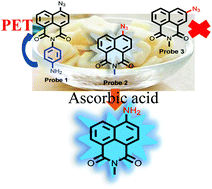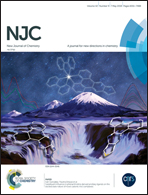New strategy for the azido–ascorbic acid reaction: a convenient chemosensor and its imaging in garlic slice tissues†
Abstract
Ascorbic acid (AA) is a vital nutritional factor in many fruits and plants, and abnormal levels of AA are closely associated with several diseases. Therefore, the development of convenient methods for monitoring AA levels in biological systems is of great importance. In this work, we designed and synthesized three chemosensors for the rapid turn-on detection of AA via a new strategy for the azido–ascorbic acid reaction. The chemosensors were based on a 1,8-naphthalimide moiety with the azide group at different sites (probes 1, 2, and 3). The experimental results demonstrated that probe 2 showed high selectivity toward AA, having an experimental limit of detection of 74 nM. Its reduction was easier than that of probe 3 with a 3-substituted azide group. Moreover, probe 2 was successfully used for imaging of AA in garlic slice tissue for the first time.



 Please wait while we load your content...
Please wait while we load your content...